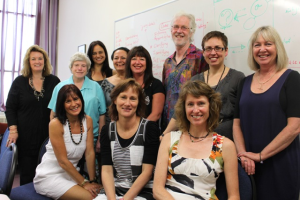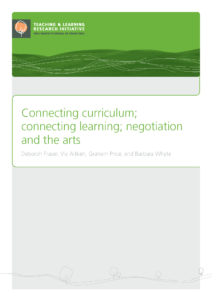Introduction
This project contributes to the field of curriculum integration and the role of the arts within integrated learning contexts. In particular, it scrutinised integrated inquiries that incorporated drama and visual art with other learning areas. It also examined ways in which children, teachers, and the wider community engaged in arts-based integration. Most of the international practices in this field fall into the “good idea” category rather than being based on research. This project helps to address this knowledge gap.
Key findings
- The most commonly integrated curriculum areas were science, social studies, technology, and English with drama and visual art.
- Scaffolding children to take on increasing adult-like responsibilities encouraged children’s engagement, initiative, and confidence with tasks.
- The introduction of well-timed tensions and challenges was necessary to sustain integration and to raise the quality of children’s engagement and learning.
- Key competencies were evident across all case studies and children’s exploration of values emerged as prominent.
Major implications
- Integrating curriculum requires teacher flexibility and negotiation of content and method.
- Positioning children as competent and capable fosters their ownership of their learning. It also influences the nature of their interactions with adults and peers.
- A crucial aspect of children’s learning is persistence and ownership gained from grappling with problems. Teachers need to recognise fertile moments for provocation and extension.
- The centrality of key competencies and values requires closer examination. It raises questions about what the arts contribute to integration and what it means to be an educated, ethical person.
The research
Background
This project built upon a previous TLRI study (the Art of the Matter, Fraser, Henderson, Price, et al., 2006) wherein negotiating the curriculum became a way across all the arts in which teachers made significant changes to their practice. While the Art of the Matter focused solely on the arts, the focus of the current project was on curriculum integration. It examined the processes by which negotiation occurs when the arts form the basis of an integrated curriculum; that is, when the arts are integrated with, or connected to, other learning areas.
The arts provide an ideal platform for integration, as a work of art reflects the larger social and cultural milieu of the artist (Efland, 2002). Integration of knowledge is maximised when cognizance is taken of how the arts reflect and inform society and culture. Indeed, culture “becomes understandable when read through its arts” and this “suggests that the arts should be centrally located within the curriculum as an overlapping domain” (Efland, 2002, p. 164).
While the arts are often used in integrated units of study (see, for example, Ewing & Simons, 2004; Fraser et al., 2006; Gibson & Ewing, 2011; Jacobs, 2004; Chicago Arts Partnerships in Education, 2009), it is evident that there is little in the way of research that studies this approach. some arts-based international practices fall more into the “good idea” category rather than in the realm of research-based practice. Bolstad (2011) argued that “it is fruitful to think about how the arts can be partnered with other curriculum areas in ways that allow each to contribute their own distinctive richness and complexity to the learning process” (p. vii).
New Zealand teachers have long practised various forms, levels and interpretations of integration, but the quality of such practice varies enormously, has seldom been researched, and relies heavily on convenient, “common sense” rituals of practice (Nuthall, 2001) rather than on a research base. This project is timely as it coincides with a school curriculum (Ministry of Education, 2007) that vests teachers with greater decision-making capacity when it comes to determining curriculum coverage, and greater flexibility in terms of subject planning. Moreover, the curriculum is founded on democratic principles such as young people being actively involved in their education, making contributions to society, and taking responsibility for their learning. These goals align smoothly with curriculum integration.
The problem persists that we have little research that provides a basis for teachers’ practice in the field of integration, and what does exist provides more confusion and dissent than clarity (as discussed by Beane, 2005; Dowden, 2006; Fraser, 2000). As Brough (2008) added, “merely combining learning areas through the use of a common theme is not a stepping stone towards student-centred integration, as the pedagogical practices that underpin student-centred versions of curriculum integration are absent” (p. 13). The role of the arts in contributing to integration is also under-researched and often misinterpreted. Bolstad (2010) found that there is considerable agreement about the need to research interactions between arts learning and other kinds of learning. Moreover, she pinpointed a need for research that scrutinises how key competencies, and the principles of the new Zealand curriculum, are developed in and through the arts.
Research questions
In particular, the project scrutinised: the connections children and teachers make between the arts and other learning areas; the influence such connections have on their engagement and learning; and the opportunities children have for shared decision-making and ownership when negotiating curriculum. Social constructivism forms the theoretical framework: it emphasises knowledge as constructed in contexts that are largely social in nature and reflects the collaborative learning environments encouraged in most contemporary classrooms. It also underlines that children’s learning is socially mediated with peers, teachers, and others within and beyond schools. Curriculum integration, negotiating the curriculum, and inquiry learning provide mechanisms by which socially constructed learning is both acknowledged and enhanced.
The specific questions that frame the study are:
- What connections are made between the arts and other curriculum areas (a) by children and (b) by teachers?
- What influence does arts-based curriculum integration appear to have on engagement and learning (a) for children and (b) for teachers?
- What opportunities are there for shared ownership and decision making in planning and negotiating the curriculum?
- How do schools foster integrated projects, founded on the arts, that maximise engagement with their communities?
Methodology and analysis
As this study focused on a few teachers and schools, qualitative approaches were most relevant. Qualitative research is concerned with an exploration of a problem and a detailed understanding of a central phenomenon (Creswell, 2005). Qualitative approaches are tailored to general and broad purposes. They usually involve participants’ experiences and feature a small number of individuals or sites. To address the above questions, a range of methodologies are required (Creswell, 2005). Such an approach enables the collection of robust and rich data that are systematically obtained and trustworthy.
The practitioner partners in the study were eight teachers from five primary schools. Two of the teachers were deputy principals, and one was without a class. Of the classroom teachers, two had Year 3 classes and five taught year 5/6 classes. All of the teachers were experienced practitioners with various positions of responsibility within their respective schools. All had a special interest in the arts and integration. the schools varied in composition from low to high decile and from predominantly Pakeha (up to 80 percent) to very multicultural (more than 50 different ethnic groups).
Case studies of teachers’ existing practice, composed by the research team, were drawn from classroom observations, interviews, learning conversations with children, work samples, camera stills, relevant document analysis and school website information. These case studies were jointly shared between the university researchers and the teacher partners and formed the basis of the action research phase. The action research cycles had a particular emphasis on appreciative inquiry; that is, on developing aspects that fostered learning and engagement of children in arts-based integration.
The particular methods employed for data collection during the action research phase included:
- observations of teachers focusing on teacher talk, teacher–child interaction patterns and teacher–child negotiations using a systematic observation chart and running records
- observations of children’s interaction with each other, with their teacher, and with their activities during lessons
- collection of work samples (including literacy)
- semi-structured interviews with teachers and wider school community members
- learning conversations with children individually and in small groups—one of the university staff as regular researcher and one using researcher-in-role; a drama strategy for taking a low status role of curiousity (audio recorder and camera stills)
- tracking engagement with an observational tool that was devised by the research team and enabled teachers to tick and date evidence of children’s engagement in learning
- interactive group activity: a diverse group of five children sorting and categorising pictures and statements from their study (audio recorder and camera stills).
Both inductive and deductive approaches to data analysis were used. In a deductive fashion, social constructivist theory and processes, such as negotiating the curriculum, were used as lenses through which to view and interpret the data. An inductive grounded theory approach was also used to remain open to the unexpected and the unpredictable, which is particularly important in research (Charmaz, 2005; Creswell, 2005). Initial line-by-line open coding of data enabled analysis to be built inductively “from the ground up without taking off on theoretical flights of fancy” (Charmaz, 1995, p. 37). Grounded theory analysis assists with keeping researchers responsive to what emerges in the data, such as the meanings that students themselves construct from arts based integrated learning. (At the time of writing this report the process of inductively mining the data is ongoing and the researchers remain open to further findings).
Major implications
The focus of learning inquiry generally determines which learning areas are incorporated within an integrated unit. This means that aiming for curriculum coverage is counterproductive and the focus of inquiry must be narrowed. In terms of the arts, music and dance did not feature within the current research project. Some teachers commented that these subjects were best taught as separate entities to ensure discipline integrity. This raises the question of when and how such decisions are made. It is no coincidence that drama and visual arts featured, given the backgrounds of the researchers and teachers in the project. Drawing upon one’s strengths in pedagogy is logical. However, one of the teachers leads her school in music and it was her conscious decision not to incorporate music in her integrated unit. This underlines the importance of not forcing learning areas together and instead drawing on those that illuminate the inquiry.
Many of the children demonstrated the ability to connect big ideas and learning areas within an integrated unit. A tool named the interactive group activity (see Whyte, Fraser, Aitken, & Price, in press) provided a vehicle for children to bring their understanding to the surface at a unit’s end. This tool revealed much more than children’s recall and recounting of events. It allowed social negotiation, idea connection, and the landing of philosophical insights underpinning the unit. It also required children to use the competency of relating to others as they negotiated their ideas amongst their group. Such a tool is useful for research and has potential for teachers as part of their assessment repertoire. It also reflects the social constructivist frame of the study.
Integrated units that featured visual art drew community involvement through the use of outside experts and parents who offered skills and support. In one case, the unfortunate incident of a school fire was the catalyst for an arts event that transformed the school environment through art installations. Local artists, parents, and other community members contributed time and talent to the arts inspired resurrection of the school grounds. In another case, print-making was taught by a professional artist and a photography unit attracted the involvement of parents and caregivers who participated in a field trip. This involvement of lay people and art professionals produced motivating home–school partnerships that extended beyond the initial art projects. Both examples provided ample evidence of children’s key competencies of participating and contributing at the school and community level.
The positioning of children as capable and competent is a salient feature of quality learning within an integrated curriculum. In some cases this happened within a clearly declared fictional adult role (the “mantle of the expert”). Where a dramatic role was used, children pursued their work “as if” they were scientists, writers, designers and so forth, while remaining aware of the “as is” world of the classroom (Aitken, 2008; Edmiston, 2003). The opportunity to operate “as if” and “as is” worlds simultaneously encourages children’s use of initiative. While the repositioning of the learner as expert was more overt in the classes that used a dramatic role, something similar was observed in all classrooms. In each case, children were scaffolded to take on increasing adult-like responsibilities and expected to wrestle with problems.
In drama, teacher-in-role and other dramatic conventions were used to bring a multitude of possible “others” into the classroom to contest thinking, ask advice, or act as an audience. The awareness of some kind of audience, whether a fictional or real audience, lent the learning a sense of intrinsic purpose and also gave a form of extrinsic motivation to encourage quality. This was also evident with the visual art integrated units.
Where teachers and researchers repositioned themselves in relation to children, this was found to alter the learning experience. For example, dialogue with children when researchers took low status roles, such as novices seeking advice, saw children advising adults on the nature of pedagogy and learning rather than merely recalling what they had done. Such use of role has benefits for both researchers and teachers when they seek to probe children’s learning in ways that invite and position children as expert commentators on their worlds.
Without well-timed tensions or challenges, integrated studies can easily revert to a series of activities that may engage children but not extend their thinking. All teachers drew on real-life issues to provoke children’s thinking. Some chose issues from immediate social reality (e.g., Fraser & Deane, 2010). Others, operating through drama, presented real-life issues within a fictional frame. These “grapplings” sustained children’s engagement, provided a sense of purpose, and raised the quality of thinking. The teacher’s ability to discern the possibilities for challenges to deepen learning was critical.
Introducing tensions and encouraging children to grapple with issues models knowledge as provisional and open to multiple perspectives. Many of the integrated units embraced complex ethical, philosophical and epistemological territory. Opening spaces for children to grapple with big issues such as the nature of reality and their place in it required quality questioning and reflection by both teachers and children.
References
Aitken, V. (2008). Pedagogical learnings of Borat for make benefit glorious community of drama teachers: What teachers can learn from Borat about frame, position and power when working in role. New Zealand Journal of Research in Performing Arts and Education: Nga Mahi a Rehia, 1 http://www.drama.org.nz/?p=394
Beane, J. (2005). A reason to teach: Creating classrooms of dignity and hope. Portsmouth, NH: Heinemann.
Bolstad, R. (2011). The contributions of learning in the arts to educational, social and economic outcomes: Part 2: A literature synthesis. Report for the Ministry of Culture and Heritage, Wellington, New Zealand.
Bolstad, R. (2010). The contributions of learning in the arts to educational, social and economic outcomes: Part 1: A review of the literature. Report for the Ministry of Culture and Heritage, Wellington, New Zealand.
Brough, C. (2008). Student-centred curriculum integration in action: “I was wondering if you could tell me how much one meat patty and one sausage costs?” set: Research Information for Teachers, 3, 9–14.
Charmaz, K. (2005). Grounded theory in the 21st century: Applications for advancing social justice studies. In N. K. Denzin & Y. S. Lincoln (eds.), The Sage handbook of qualitative research (3rd ed., pp. 507–536). Thousand Oaks, CA: Sage.
Charmaz, K. (1995). Grounded theory. In J. A. Smith, R. Harre & L. V. Langenhove (Eds.), Rethinking methods in psychology (pp. 27–49). London, England: Sage.
Chicago Arts Partnerships in Education. (2009). Research and evaluation series: Contributions to arts and learning. retrieved from http:// www.capeweb.org/rcurrent.html
Creswell, J. W. (2005). Educational research: Planning, conducting and evaluating quantitative and qualitative research (2nd ed.). Upper Saddle River, NJ: Pearson Education.
Dowden, t. (2006). Curriculum integration for early adolescent schooling in Aotearoa New Zealand: Worthy of serious trial? Unpublished doctoral thesis, Massey University, Palmerston North, New Zealand.
Edmiston, B. (2003). What’s my position? Role, frame and positioning when using process drama. Research in Drama Education, 8(2), 221–230.
Efland, A. (2002). Art and cognition: Integrating the visual arts in the curriculum. New York, NY: Teachers College Press.
Ewing, R., & Simons, J. (2004). Beyond the script: Drama in the classroom take two. Newtown, NSW, Australia: PETA.
Fraser, D. (2000). Curriculum integration: What it is and is not. set: Research Information for Teachers, 3, 34–37.
Fraser, D., & Deane, P. (2010). Making a difference: Agents of change through curriculum integration. set: Research Information for Teachers, 3, 10–14.
Fraser, D., Henderson, C., Price, G., Bevege, F., Gilbert, G., Goodman, … Tyson, S. (2006). The art of the matter. The development and extension of ways of knowing in the arts. Teaching and Learning Research Initiative Final Project report. Wellington, New Zealand: NZCER.
Gibson, R., & Ewing, R. (2011). Transforming the curriculum through the arts. South Yarra: Palgrave Macmillan.
Jacobs, H. H. (2004). Getting results with curriculum mapping. Alexandria, VA: ASCD.
Ministry of Education. (2007). The New Zealand curriculum. Wellington, New Zealand: Learning Media.
Nuthall, G. (2001, December). The cultural myths and realities of teaching and learning. Paper presented at the New Zealand Association for Research in Education, Christchurch, New Zealand.
Whyte, B., Fraser, D., Aitken, V., & Price, G. (in press). interactive group activity. A socially mediated tool for opening an interpretive space in classroom research. International Journal of Qualitative Studies in Education.
Project Team

Deborah Fraser, Viv Aitken, Graham Price, and Barbara Whyte: University of Waikato researchers Elicia Pirini, Penny Deane, Nicki Keys, Gay Gilbert, Lynette Townsend, Whakarongo Tauranga, Coryn Knapper, and Michelle Parkes: teachers






